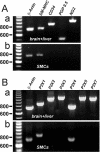Purinoreceptor-mediated current in myocytes from renal resistance arteries
- PMID: 20590593
- PMCID: PMC2936003
- DOI: 10.1111/j.1476-5381.2010.00714.x
Purinoreceptor-mediated current in myocytes from renal resistance arteries
Abstract
Background and purpose: Ionotropic purinoreceptors (P2X) in renal vascular smooth muscle cells (RVSMCs) are involved in mediating the sympathetic control and paracrine regulation of renal blood flow (RBF). Activation of P2X receptors elevates [Ca(2+)](i) in RVSMCs triggering their contraction, leading to renal vasoconstriction and decrease of RBF. The goal of the present work was to characterize the P2X receptor-mediated ionic current (I(P2X)) and to identify the types of P2X receptors expressed in myocytes isolated from interlobar and arcuate arteries of rat kidney.
Experimental approach: The expression of P2X receptors in isolated RVSMCs was analysed by reverse transcription (RT)-PCR. I(P2X) and membrane potential were recorded using the amphotericin B-perforated patch method.
Key results: RT-PCR analysis on single RVSMCs showed the presence of genes encoding P2X1 and P2X4 receptors. Under voltage clamp conditions, the selective P2X receptor agonist alphabeta-methylene ATP (alphabeta-meATP) evoked I(P2X) similar to that induced by ATP. Under current clamp conditions, both ATP and alphabeta-meATP evoked a spike-like membrane depolarization followed by a sustained depolarization, linking P2X receptors in RVSMCs to sympathetic control of renal vascular tone. A selective antagonist of P2X1 receptors, NF279, reduced I(P2X) amplitude by approximately 65% concentration-dependently manner within the nanomolar to sub-micromolar range. The residual current was resistant to micromolar concentrations of NF279, but was inhibited by sub-millimolar to millimolar concentrations of NF279.
Conclusions and implications: Two types of functional P2X receptors, monomeric P2X1 and heteromeric P2X1/4 receptors, are expressed in RVSMCs. Our study has identified important targets for possible pharmacological intervention in the sympathetic control of renal circulation.
Figures






References
-
- Bo X, Burnstock G. Characterization and autoradiographic localization of [3H] alpha, beta-methylene adenosine 5′-triphosphate binding sites in human urinary bladder. Br J Urol. 1995;76:297–302. - PubMed
Publication types
MeSH terms
Substances
Grants and funding
LinkOut - more resources
Full Text Sources
Miscellaneous

